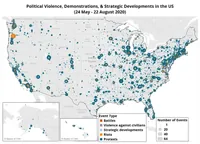U.S. Household Incomes Rise, But Economic Challenges Persist
Census Bureau report shows 4% income increase in 2023, yet remains below pre-pandemic levels. Despite economic growth, many Americans express dissatisfaction amid ongoing financial pressures.

The U.S. Census Bureau, established in 1903, has released a new report revealing a complex economic landscape for American households. For the first time since 2019, median household incomes increased by 4% in 2023, reaching $80,610. However, this figure still falls short of the pre-pandemic level of $81,210 recorded in 2019.
Kristin Seefeldt, a professor at the University of Michigan, commented on the findings:
"The good news is there's been a 4 percent rise in income. But it's also true that families are facing financial challenges. Rent has gone up so much; groceries are more expensive; the price at the pump is higher."
This statement encapsulates the mixed economic signals that many Americans are grappling with. While incomes have risen, the cost of living continues to pose significant challenges for many families.
The report highlights persistent disparities along racial and gender lines. White households experienced a 5.4% increase in income, while Black, Asian, and Hispanic households saw little change. The gender pay gap also widened, with women earning 83 cents for every dollar paid to men. This trend is particularly noteworthy given that the gender pay gap has been narrowing since the 1980s, though it clearly remains a significant issue.
Inflation, which peaked at 9.1% in June 2022, has since moderated to 2.9% year-over-year. However, the prices of essential goods and services, including housing, food, and utilities, remain significantly higher than in previous years. It's worth noting that the highest annual inflation rate in U.S. history was a staggering 29.78% in 1778, putting current inflation levels into historical perspective.

Despite these challenges, the U.S. economy has shown remarkable resilience. The unemployment rate stands at 4.2%, close to historic lows. For context, the lowest unemployment rate in U.S. history was 1.2% in 1944, during World War II. The economy continues to add thousands of jobs monthly, driving consumer spending.
Arloc Sherman, vice president at the Center on Budget and Policy Priorities, offered a positive interpretation of the data:
"The bottom line is, this was a strong economic year. We saw workers making gains and employment rising about as fast as it has any time in the last 30 years. This is the clearest evidence yet that incomes grew faster than inflation did for ordinary households."
The White House has welcomed the income growth news, particularly in light of the upcoming election. Jared Bernstein, chair of the president's Council of Economic Advisers, emphasized the role of policy in these outcomes, citing the impact of the Affordable Care Act on uninsured rates.
However, the report also revealed some concerning trends. The poverty rate, adjusted to include government aid programs, rose to 12.9% from 12.5% in 2022. Child poverty also increased to 13.7% from 12.4%. Interestingly, the official poverty rate fell to 11.1%, creating a discrepancy that economists are still trying to understand. The concept of the poverty threshold, developed by Mollie Orshansky in the 1960s, continues to be a crucial metric in assessing economic well-being.
As the nation approaches the election, these economic indicators will likely play a significant role in shaping public opinion and policy debates. The challenge for policymakers will be to address the persistent issues of inequality and affordability while building on the positive trends in income growth and employment.


































